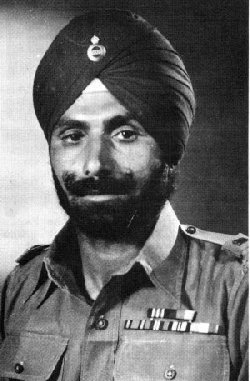Lance Naik Karham Singh (P.V.C.)
Karham Singh was born on 15 September 1915 at Sehna village in Sangrur District of Punjab in the house of Sardar Uttam Singh. With the Japanese invasion of China and a threatened invasion of India via Burma, he enlisted into the Army as number 22356 of First Sikh regiment as Sepoy on 15 September 1941.
Fighting in the deep jungles of Burma in 1945 against the seemingly unstopable forces of the Japanese he won the highest award for bravery given by the British Army. He is the only Indian soldier to win the highest medals of both the British and Indian governments. With the award of the VC he was promoted from Sepoy to Lance Naik.
On 15th August 1947 India gained its independence from Britain and thus the Army was now transferred under Government of India. In January of 1948, Pakistan army launched an offensive against the state of Kashmir's ruler, in an effort to retain his Kingdom as a Princely State, had not specified whether he was joining Pakistan or India. With a sudden Pathan push to grab territory advancing deeply into his Kingdom Maharaja Hari Singh, at the last moment, joined the Indian union and thus Kashmir's defense fell suddenly on the shoulders of the Indian Army and men like Karham Singh.
1 Sikh Regiment was airlifted to Srinagar and tasked with defending Kashmir against the offensive attack of the enemy. A few kilometers away from Srinagar, the town of Tithwal was soon recaptured by the Sikh Regiment which forced the Pakistanis back across the Kishanganga River. Defences against the enemy onslaught were prepared all around the city. Lance Naik Karam Singh and his men were posted just outside Tithwal.
The enemy made numerous attempts to recapture Richhmar Gali and thence Tithwal. On 13 October 1948, coinciding with Id, the enemy decided to launch a brigade strength attack to retake Richhmar Gali and chose to bypass Tithwal and advance on into the Srinagar Valley. L/Nk Karam Singh was commanding a section directly in their path. The enemy commenced its attack with heavy shelling of guns and mortars. Their fire was so accurate that not a single bunker in the platoon's locality was left unscathed all of the communications trenches were caved in.
Bravely, L/Nk Karam Singh went from bunker to bunker, tending the wounded and urging the men to fight. The enemy launched eight separate attacks that day. In one such attack, the enemy managed to obtain a foothold in the platoon's locality. Twice wounded, he refused evacuation and continued to hold on to the first-line trenches. The fifth enemy attack was very intense. Two enemy soldiers came so close to his position that he could not engage them without hitting his men. Lance Naik Karam Singh, jumped out of his trench and bayoneted the two intruders to death. This bold action so demoralised the enemy that they broke off the attack. The last three enemy attacks were also repulsed by Lance Naik Karam Singh and his men.
Having proved himself to be a dauntless and born leader of men in crisis he was honoured with the highest wartime gallantry medal, the Param Vir Chakra, for his outstanding role in the battle of Tithwal. His gallant actions on that day inspired his colleagues to face the massive onslaught unflinchingly. It was his fiercely proud spirit which was largely responsible for the gallant stand at Tithwal that day.
Lance Naik Karham Singh retired from the Army as Subedar and honorary captain.
Salute to Khalsa Warrior Karham Singh.
The Paramvir Chakra, which was awarded to Lance Naik Karham Singh is the highest medal for gallantry of the Indian Military. Since 1947, Indian defense forces have participated in various campaigns all around India and the world. India fought three wars with Pakistan in 1948, 1965 and in 1971 and one war with china in 1962.

